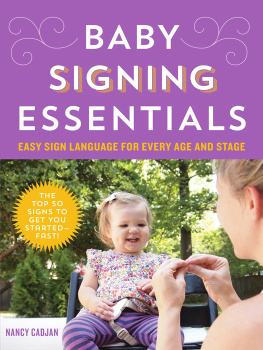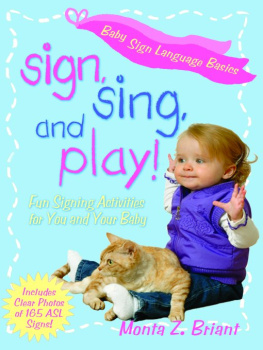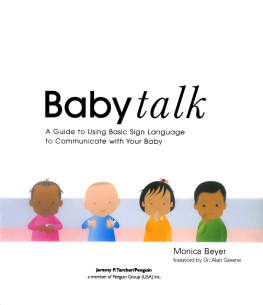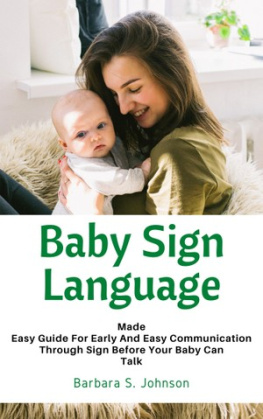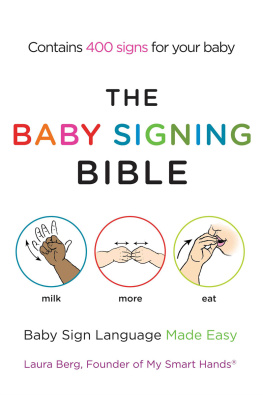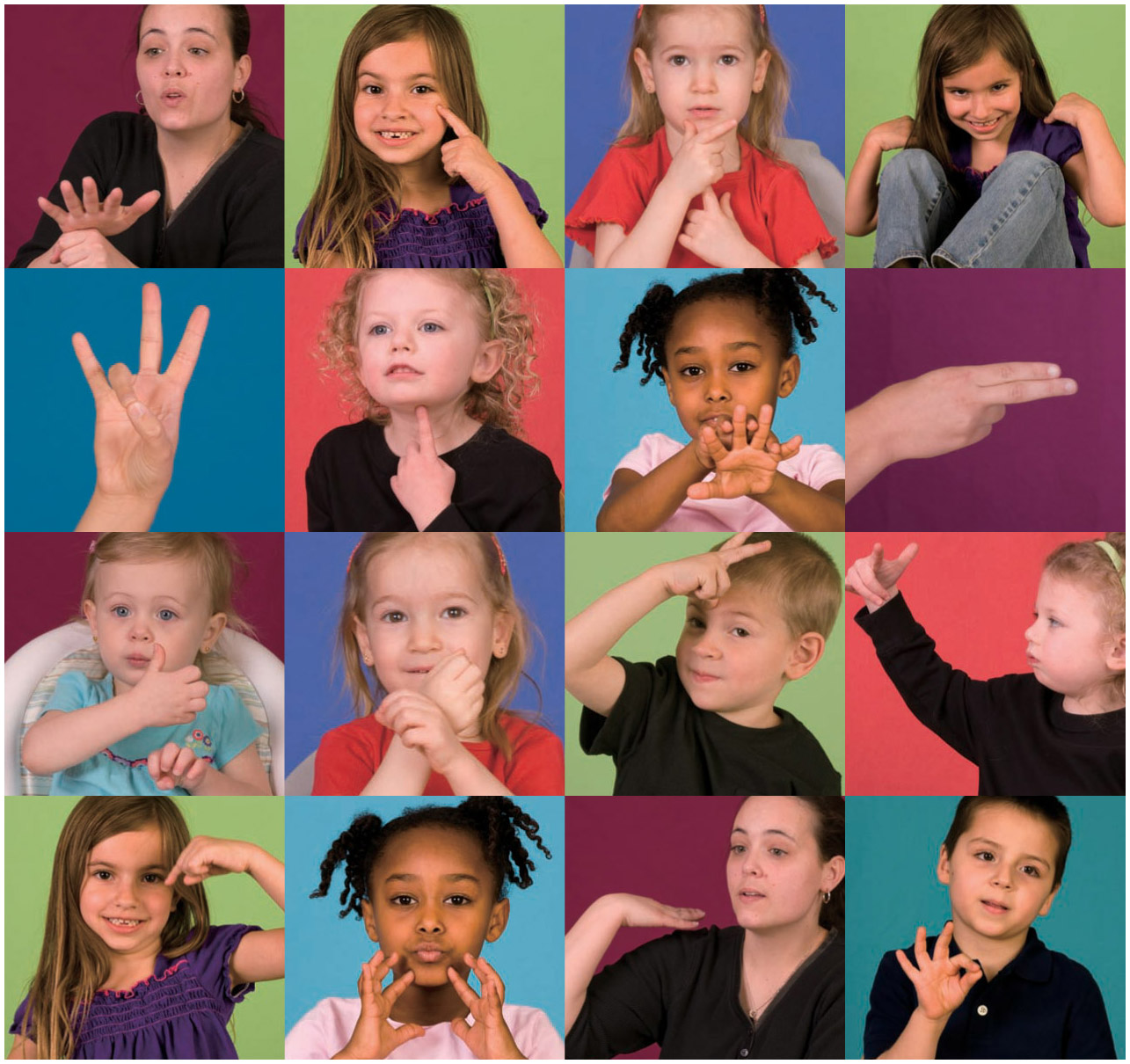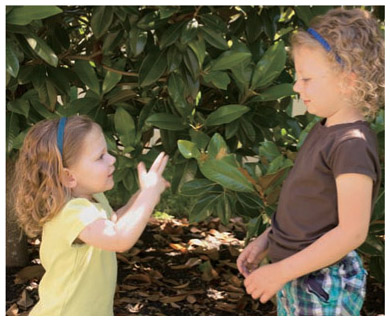BABY
SIGN LANGUAGE
Copyright 2010 by Morris Book Publishing, LLC
ALL RIGHTS RESERVED. No part of this book may be reproduced or transmitted in any form by any means, electronic or mechanical, including photocopying and recording, or by any information storage and retrieval system, except as may be expressly permitted in writing from the publisher. Requests for permission should be addressed to Globe Pequot Press, Attn: Rights and Permissions Department, P.O. Box 480, Guilford, CT06437.
Knack is a registered trademark of Morris Publishing Group, LLC, and is used with express permission.
Editor-in-Chief: Maureen Graney
Editor: Imee Curiel
Cover Design: Paul Beatrice, Bret Kerr
Text Design: Paul Beatrice
Layout: Joanna Beyer
Cover and interior photos by Johnston Bell Grindstaff
Library of Congress Cataloging-in-Publication Data
Chafin, Suzie.
Knack baby sign language : a step-by-step guide to communicating with your little one / Suzie Chafin ; photographs by Johnston Grindstaff; technical review by Anne E. Pidano.
p. cm.
Includes index.
ISBN 978-1-59921-614-0
1. Nonverbal communication in infantsStudy and teaching.
2. Interpersonal communication in infantsStudy and teaching.
3. American Sign LanguageStudy and teaching. I. Title.
BF720.C65C43 2010
419.1dc22
2009029672
The following manufacturers/names appearing in Knack Baby Sign Language are trademarks: Band-Aid, Barbie, Plexiglas, Velcro
The information in this book is true and complete to the best of our knowledge. All recommendations are made without guarantee on the part of the author or Globe Pequot Press. The author and Globe Pequot Press disclaim any liability in connection with the use of this information.
Printed in China
10 9 8 7 6 5 4 3 2 1
Author Dedication
For Sam, Lauren, Jon, and James, who showed me signing with babies is possible. For Andy, who helped me teach them.
S.C.
Author Acknowledgments
I am deeply indebted to several people who made this work possible. First, my thanks and gratitude to Maureen Graney for giving me the opportunity to write this book and for her support, encouragement, and contributions. Thank you, Imee Curiel, for your direction, insight, and support. John Grindstaffs photographs and artistic influence provide the visual backbone for this book. Thank you, John, for your fabulous work. Barb Doyen, once again thank you for your support, representation, and constant words of encouragement. Last, thank you to my family for the sacrifices you each made so I could work on this book.
S.C.
Photographer Dedication
To my mother, Dorothea Grindstaff, for your love and for believing in me.
J.G.
Photographer Acknowledgments
Thanks to the publishing team at Globe Pequot Press, especially Maureen Graney, Imee Curiel, and Katie Benoit, for giving me an opportunity to do the photography for this unique book. And to author Suzie Chafin for her gifted writing to reveal beautiful words. Also thanks to the beautiful and handsome models Tilde Edington, Tindra Edington, Barry Elliott, Laine Elliott-Mendelsohn, Zora Elliott-Mendelsohn, Hanna Johnston-Shaw, Camela Klusza, Leia Klusza, Joshua Mendelsohn, Grace Nathanson, Dov Nathanson, Zeke Ortiz, and Zion Ortizfor their time and help with ideas in the art of ASL. Special thanks to the parents of the child models for their time and willingness to work with me.Thanks to my wife, Natalie, for her boundless help as a sign master, assistant, and much more.Thanks to my children, Jarvis, Raquel, and Jake, for their support.
J.G.
INTRODUCTION
So you want to teach your child sign language? Youve just taken the first step to making that goal a reality. You may be wondering,Can it really be done? Is it really possible to teach my little baby to talk using sign language? Unequivocally yes.
All four of my children used sign language during the first two years of their lives (and beyond). My oldest, with whom I had the most time to spend working, picked up a large vocabulary and used signs often. Because he had chronic ear infections, signing was especially helpful for him. He could easily communicate with me when his ear was hurting, or when he was hungry, and tell me what he wanted, all just using his hands. When his little sister was born just 21 months after him, he helped teach the signs to her. Several years later came our identical twin boys, who also signed. By then, time was a precious commodity. Even with four kids five years of age and younger, we were still able to teach sign language and found it to be a very useful and effective communication tool.Though our twins didnt have the signing vocabulary that our oldest had, using a core group of signs made my life easier and simpler.
Today, though those baby twins are now nine years old, sign language still peppers our everyday conversations. The I love you sign is used often, through car windows, and at bedtime just before we close the door. Even just walking through the room, we often raise our hands, saying, I love you,and our kids are reminded by that simple gesture that we love them. My oldest, now a 14-year-old milk addict, still asks for milk by flashing me the milk sign. While eating, if the kids mouths are full they still ask for more using their hands. On a recent vacation we were able to communicate across ski lift lines with simple commands like wait and stop. So, does sign language have a benefit beyond the baby years? Absolutely!
The Benefits of Sign Language
If you are interested in achieving effective communication with your child, positioning your child for greater classroom success later, and having a less frustrated and more content child, teaching sign is well worth the effort.
1. Increased Communication
Imagine being able to understand, talk, and communicate easily and effectively with your six month old. Who wouldnt want that ability, right? Sign language makes this possible. As early as the age of six months, your baby is able to begin repeating, understanding, and using sign language to tell you what he wants or needs.
Effective give-and-take verbal communication usually does not occur until your child is around 18 months old, which means using sign language can potentially allow you to understand and communicate a full year earlier. You wont have to wonder if a cry means your baby is hungry, tired, or wants a favorite blanket or pacifier. Instead, through sign, baby will tell you, eliminating the crying guessing game. Not only will you understand baby earlier, but you and baby will experience less frustration and fewer tears, and the moments that you spend together will be more fulfilling without the aggravation of misunderstandings.


